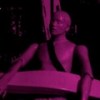Last week, I had a picture of a live spider for you to identify. Most of the guesses came quickly, and were absolutely correct - the spider in the picture was a Spiny-Backed Orbweaver. This week's arthropod might be a little more challenging.
The picture below features a pinned museum specimen, and was taken through a light microscope at about 40x magnification. The edge of a quarter appears in the photo for scale. The species in question is unique to the island of Hawaii, and is found on the wetter slopes of the younger volcanoes.
Good luck. I'll post either the answer (if someone got it right) or a hint on Monday.
More like this
tags: spider, tarantula, chicken-eating spider
Have you been getting bitten by a lot of spiders lately? Are you concerned about Brown Recluse Spiders?
Well, I know people don't like to hear this, but those spider bites you woke up with this morning were probably not spider bites. Spiders don't really bite people.
Check out this "sculpure" of a spider discovered by Biologist Phil Torres, created by what may be a new species of Cyclosa found in the Peruvian Amazon.
A loose spider on a space station.


Looks like a picture wing fly. I can't tell you what species. Its wings look like the wings of Drosophila planitibia that I saw in the Edwards et al 2007 paper in PLoS ONE "A Database of Wing Diversity in the Hawaiian Drosophila"
You'll need to post more pictures. It is most likely a Drosophila. But there is a surpising diversity in little tiny flies, and the charactistics that safely separate Drosophilidae from the other more obscure families are not visible. Also considering there is 500+ species of Drosophila (most undescribed)in the Hawaiin Islands, a species identification might be more deficult.
It is a Hawaiian Drosophila. It is not D. planitibia, but that guess was very close in phylogenetic terms.
I'm not going to post additional pictures, not because I can't, but because there's enough in that picture.
Here's your hint: Don't focus on the wings. Use its head.
Drosophila heteroneura. Based on location and habitat.